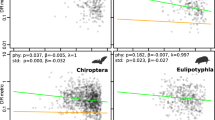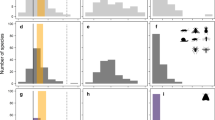Abstract
Within taxonomic groups, there is almost always a positive relationship between the size of geographic range and the local abundance of species1,2,3,4. This pattern has attracted much interest, and several ecological mechanisms have been proposed as causes of it5. However, these hypotheses do not consider the effect of the extinction of rare species on range-abundance relationships. If both range size and local abundance influence the risk of extinction, species with small ranges might avoid extinction if they have high local abundance, whereas species with low local abundance might avoid extinction if they are widespread; species with both small range and low local abundance should be at high risk. This interaction between range, abundance and extinction should produce negative correlations between range and abundance in groups that have experienced many extinctions. Here I test this idea using Australian marsupials, and I show that although the relationship between range size and local abundance is positive for recently evolved species, it is negative for ancient species. This indicates that positive relationships between range size and abundance may be generated during adaptive radiation, but are then gradually reversed as a result of differential extinction.
This is a preview of subscription content, access via your institution
Access options
Subscribe to this journal
Receive 51 print issues and online access
$199.00 per year
only $3.90 per issue
Buy this article
- Purchase on Springer Link
- Instant access to full article PDF
Prices may be subject to local taxes which are calculated during checkout


Similar content being viewed by others
References
Hanski, I. Dynamics of regional distribution: the core and satellite species hypothesis. Oikos 38, 210–221 (1982).
Brown, J. H. On the relationship between abundance and distribution of species. Am. Nat. 124, 255–279 (1984).
Lawton, J. H., Nee, S., Letcher, A. J. & Harvey, P. H. in Large-scale Ecology and Conservation Biology(eds Edwards, P. J., May, R. M. & Webb, N. R.) 41–58 (Blackwell Scientific, London, (1994)).
Gaston, K. The multiple forms of the interspecific abundance-distribution relationship. Oikos 76, 211–220 (1996).
Gaston, K. J., Blackburn, T. M. & Lawton, J. H. Interspecific abundance-range size relationships: an appraisal of mechanisms. J. Anim. Ecol. 66, 579–601 (1997).
Diamond, J. M. in Extinctions(ed. Nitecki, M. H.) 191–246 (Univ. Chicago Press, Chicago, (1984)).
Pimm, S. L. The Balance of Nature? Ecological Issues in the Conservation of Species and Communities(Univ. Chicago Press, Chicago, (1991)).
Caughley, G. Directions in conservation biology. J. Anim. Ecol. 63, 215–244 (1994).
McKinney, M. L. in The Biology of Rarity: Causes and Consequences of Rare-Common Differences(eds Kunin, W. E. & Gaston, K. J.) 110–129 (Chapman & Hall, London, (1997)).
Gaston, K. J. Species-range size distributions: products of speciation, extinction and transformation. Phil. Trans. R. Soc. Lond. B 353, 219–230 (1998).
Bennett, P. M. & Owens, I. P. F. Variation in extinction risk among birds: chance or evolutionary predisposition? Proc. R. Soc. Lond. B 264, 401–408 (1997).
Cotgreave, P. & Pagel, M. in The Biology of Rarity(eds Kunin, W. E. & Gaston, K. J.) 237–261 (Chapman & Hall, London, (1997)).
Strahan, R. The Mammals of Australia(Reed, Sydney, (1995)).
Kirsch, J. A. W., Lapointe, F.-J. & Springer, M. S. DNA-hybridisation studies of marsupials and their implications for metatherian classification. Aust. J. Zool. 45, 211–280 (1997).
Groves, C. P. & Flannery, T. F. in Bandicoots and Bilbies(eds Seebeck, J. H., Wallis, R. L., Brown, P. R. & Kemper, C. M.) 1–11 (Surrey Beatty, Sydney, (1990)).
Close, R. L., Murray, J. D. & Briscoe, D. A. in Bandicoots and Bilbies(eds Seebeck, J. H., Brown, P. R., Wallis, R. L. & Kemper, C. M.) 19–27 (Surrey Beatty, Sydney, (1990)).
Baverstock, P. R., Krieg, M. & Birrell, J. Evolutionary relationships of Australian marsupials as assessed by albumin immunology. Aust. J. Zool. 37, 273–287 (1990).
Archer, M. in Carnivorous Marsupials(ed. Archer, M.) 397–443 (R. Zool. Soc. New South Wales, Sydney, (1982)).
Baverstock, P. R., Archer, M., Adams, M. & Richardson, B. J. in Carnivorous Marsupials(ed. Archer, M.) 641–650 (R. Zool. Soc. New South Wales, Sydney, (1982)).
Archer, M. Results of the Archbold Expeditions No. 104. Systematics of the marsupials genus Sminthopsis Thomas. Bull. Am. Mus. Nat. Hist. 168, 61–224 (1981).
Flannery, T. F. Possums of the World(GEO/Australian Museum, Sydney, (1995)).
Flannery, T. F. in Kangaroos, Wallabies and Rat-kangaroos(eds Grigg, G., Jarman, P. & Hume, I.) 1–46 (Surrey Beatty, Sydney, (1989)).
Colgan, D. J. & Flannery, T. F. Biochemical studies of the genus Petaurus (Marsupialia: Petauridae). Aust. J. Zool. 40, 245–256 (1992).
Eldridge, M. D. B., Johnston, P. G. & Close, R. L. Chromosomal rearrangements in rock wallabies, Petrogale (Marsupialia: Macropodidae). V. Chromosomal phylogeny of the lateralis/panicillata group. Aust. J. Zool. 39, 629–641 (1991).
Purvis, A. & Rambaut, A. Comparative analysis by independent contrasts (CAIC): an Apple Macintosh application for analysing comparative data. Comp. Appl. Biosci. 11, 247–251 (1995).
Harvey, P. H. & Pagel, M. D. The Comparative Method in Evolutionary Biology (Oxford Univ. Press, Oxford, (1991)).
Pagel, M. D. Amethod for the analysis of comparative data. J. Theor. Biol. 156, 431–442 (1992).
May, R. M., Lawton, J. H. & Stork, N. E. in Extinction Rates(eds Lawton, J. H. & May, R. M.) 1–24 (Oxford Univ. Press, Oxford, (1995)).
Blackburn, T. M., Lawton, J. H. & Perry, J. N. Amethod of estimating the slope of upper bounds of plots of body size and abundance in natural animal assemblages. Oikos 65, 107–112 (1992).
Acknowledgements
I thank M. Blows, J. Caley and L. Schwarzkopf for comments; A. Payne for help in compiling data on range size; A. Cockburn for providing facilities at the Division of Botany and Zoology at the Australian National University; and S. Burnett, A. Dennis, M. Evans, A. Horsup, S. Jackson, P.Jarman, L. Leong, R. Martin, A. Melzer, G. Newell, M. Runcie, K. Vernes, P. Winkel, J. Winter and A.Woolnought for unpublished data on population densities. This work was partly supported by a grant from the ARC.
Author information
Authors and Affiliations
Corresponding author
Rights and permissions
About this article
Cite this article
Johnson, C. Species extinction and the relationship between distribution and abundance. Nature 394, 272–274 (1998). https://doi.org/10.1038/28385
Received:
Accepted:
Issue Date:
DOI: https://doi.org/10.1038/28385
This article is cited by
-
Mutual interference as a factor for the cooccurrence and population dynamics of insect predator and mosquito prey system: validating through models
Environmental and Ecological Statistics (2024)
-
Elevated extinction risk of cacti under climate change
Nature Plants (2022)
-
On the occurrence of the Critically Endangered blond titi (Callicebus barbarabrownae): reassessment of occupied areas and minimum population size
International Journal of Primatology (2022)
-
Winners and losers in the predicted impact of climate change on cacti species in Baja California
Plant Ecology (2021)
-
Riparian vegetation dynamics in protected and unprotected areas, Kumawu District—Ashanti Region (Ghana)
Tropical Ecology (2021)
Comments
By submitting a comment you agree to abide by our Terms and Community Guidelines. If you find something abusive or that does not comply with our terms or guidelines please flag it as inappropriate.



